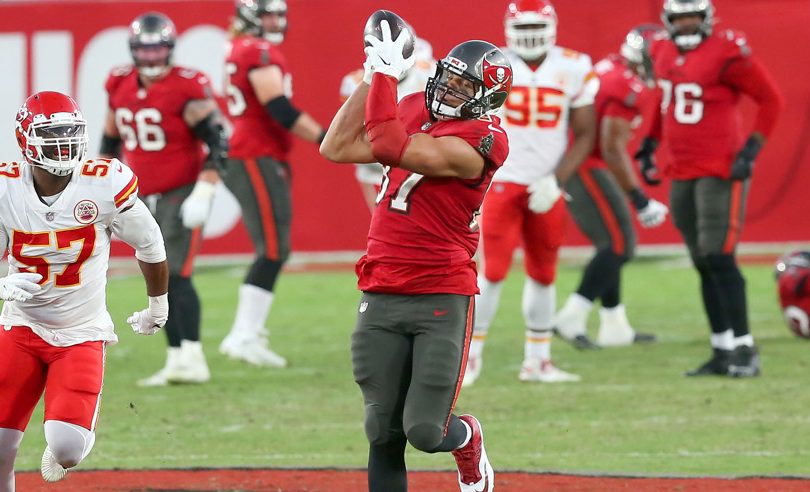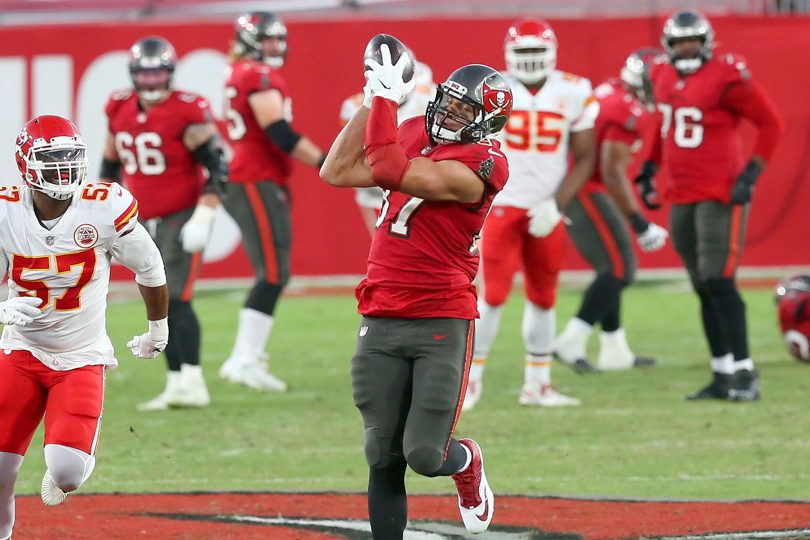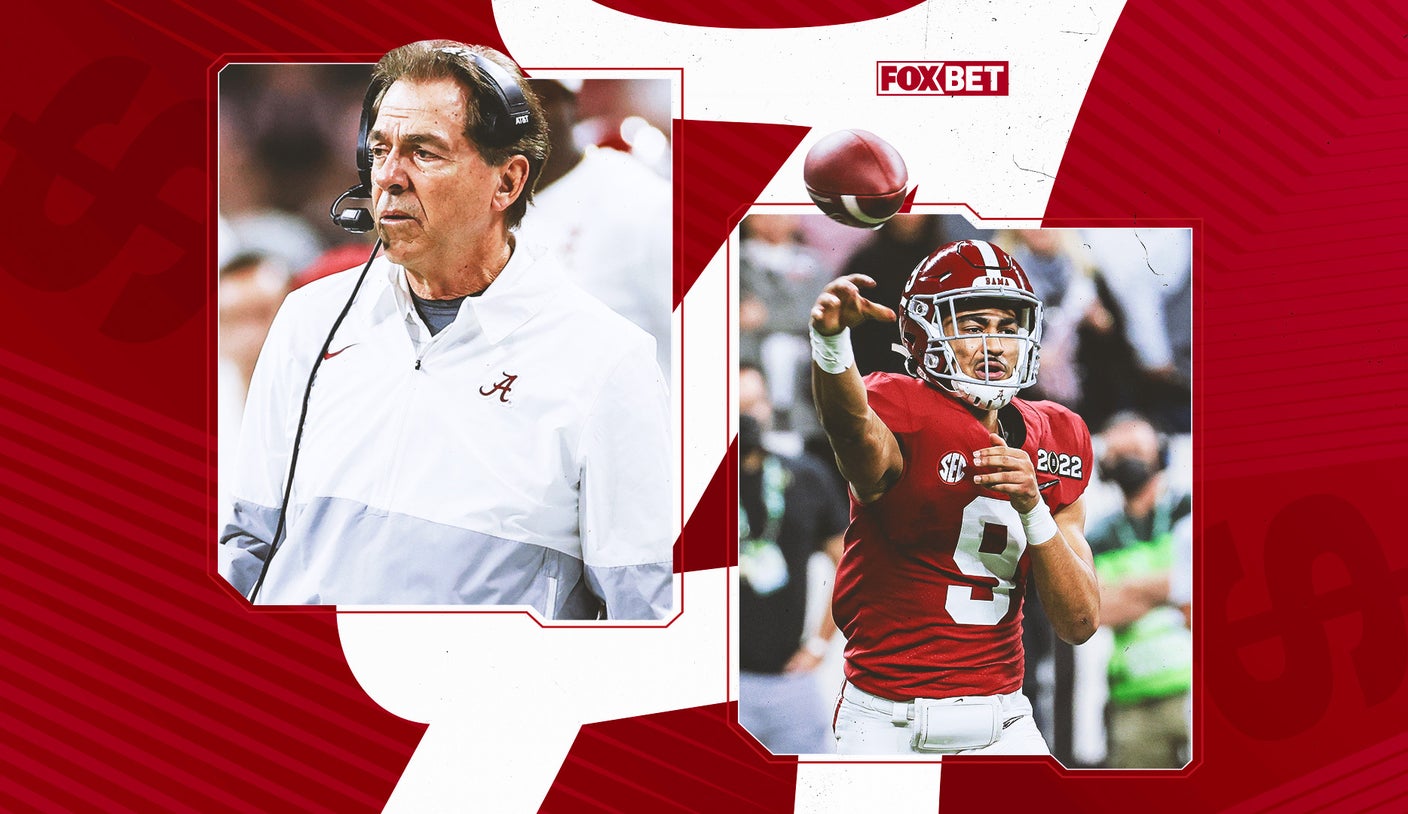Super Bowl Squares Pools: Strategy & Square Values For Super Bowl LV
February 4, 2021 – by Jason Lisk

Rob Gronkowski is a fan of the 6-9 square, while we prefer 7-0 (Photo by Cliff Welch/Icon Sportswire)
In this post, we analyze the popular Super Bowl Squares betting game, a contest played and loved by so many Super Bowl party attendees nationwide.
Our primary intent is to estimate the value of squares for Super Bowl LV between the Kansas City Chiefs and the Tampa Bay Buccaneers, using an objective and targeted approach to square valuation based on historical scoring patterns.
Armed with the data and observations in this post, you should hopefully be able to pick, trade, buy, or bid your way to a bigger edge in your Super Bowl Squares pool. But even if your pool doesn’t allow any of that, you’ll at least have a solid idea of how likely your squares are to win a prize.
How Super Bowl Squares Pools Work
Content:
ToggleIn the popular Super Bowl Squares betting game, each pool entry is associated with a pair of single-digit whole numbers (0 to 9), one number for each team. For example, an entry this year might have 4 for Kansas City and 0 for Tampa Bay.
The numbers associated with each entry can be determined in a variety of ways, such as:
Random assignment by the pool administratorA “draft” where players pick their own squaresAn auction among players
Each number represents the last digit of the score for the associated team. Because there are 10 potential numbers for each team, there are 100 unique squares (10 x 10) available in total.
Once all squares have been assigned or sold, the score of the Super Bowl at various points (usually at the end of each quarter) will then determine who wins prizes.
For instance, the Kansas City 4, Tampa Bay 0 square cited above would win the second quarter pot if the Super Bowl’s halftime score is Kansas City 14, Tampa Bay 10. In that case, Kansas City’s score ends in 4, and Tampa Bay’s score ends in 0.
Not All Super Bowl Squares Are Worth The Same
We are going to use data to generate value estimates for all 100 Super Bowl Squares this year, because some squares are worth much more than others in terms of giving you a chance to win a prize.
Because NFL point scoring happens in certain specific increments (e.g. 3 points for a field goal, 7 points for a touchdown plus extra point), certain numbers aren’t often the final digits of scores that are multiples or combinations of common scoring increments. Those numbers make for lousy squares, and vice versa.
How To Value Squares
Some people will try to dig up data on historical NFL score frequencies to research and value squares. That is definitely a step in the right direction, but we can go further by targeting our analysis of historical score frequency toward games that were most similar to Super Bowl LV between the Chiefs and Buccaneers.
Even if you are randomly assigned your square(s) in your pool, which is the most common rule variation, you can still use the square value estimates in this post to understand your rough expectation for prize winnings. In addition, you can use the value estimates to trade, barter, buy or sell or squares after your pool’s drawing, and hopefully pick up a bigger.
Of course, if you can bid on or otherwise select your own squares, you can use the estimated square values as a guide for which square to pick next or how much it’s worth paying for a certain square.
Estimating the Value of Super Bowl Squares for Super Bowl LV
To estimate the value of squares for the Super Bowl LV matchup between Kansas City and Tampa Bay, we examined scores from relevant past games to see how often each scoring outcome occurred in each quarter.
The games we deemed relevant share the following characteristics:
Played since the start of the 2015 season. That’s when the NFL adopted changes to the extra point attempt rules, making misses more common, which had a significant impact on score distributions.Had a point spread of 8 points or less. We exclude matchups that were expected to be relative blowouts, since Super Bowl LV is expected to be pretty close (the Chiefs were favored by 3 or 3.5 at post time).Had an over/under line of 48 points or more. We exclude matchups that were expected to be much lower scoring than Super Bowl LV (the over/under was 55 at post time). By doing so, we tend to bring in matchups with better quarterbacks that more closely mirror the top-tier QB matchup between Patrick Mahomes and Tom Brady.
Applying the constraints above provides a data set of 431 games (including both playoffs and regular season) to examine.
Ready to bet the Big Game? Check out the best available Super Bowl betting offers and signup bonuses from legal, US-based online sportsbooks. See offers »
Balancing Relevance and Sample Size
In taking this approach, we need to weigh historical game relevance against having a larger sample size of data. After all, we could have included every game in the NFL over the last 30 years and analyzed quarter-end scoring patterns for thousands of historical games.
However, NFL scores from way back in 1995 don’t seem especially relevant today, considering the extra point rules changes plus significantly increased overall scoring in recent years, as passing has become more prevalent in the NFL.
On the other hand, we also could have been more strict with our point spread and over/under cutoffs, and limited our data set to games that were even more similar to Super Bowl LV in terms of pre-game betting lines. However, that would have reduced the sample size even further.
We think this set of 431 games is a good tradeoff, though admittedly, it is not a huge sample size. So the square values we’ve generated by looking at these past outcomes should be viewed more as estimates than highly precise values.
For Super Bowl LV, for instance, we are confident that the 7-0 square is significantly more valuable than the 4-6 square, and that 4-6 is far more valuable than 5-5. But squares valued closely to one other should be seen as equal/in the same ballpark.
Assigning Values to the Super Bowl Squares
At the very end of this post, you’ll find two big charts:
One will have the percentage of times each number combination hit each quarter, in our 431-game sample of similar historical games. This chart can be used to calculate an expected value of each square for a variety of possible scoring systems.The other chart is a value chart, with a by-quarter and total overall estimated value, in dollars, for each Super Bowl LV square. This chart assumes a specific pool scoring system (explained next).
For the sake of quick understanding and comparison, the dollar values of squares in the value chart are based on a sample pool where:
Each entry costs $10.There are 100 entries.Prizes are paid out by quarter.20% of the pot goes to the 1st quarter, 2nd quarter, and 3rd quarter winner; 40% goes to the final score winner.
Using Score Frequencies To Determine Square Values
As an example of the underlying data at work here:
It turns out that 58 of the first quarter scores in our 431-game sample of games similar to Super Bowl LV would have been won by the 0-0 square. That was the highest first quarter frequency for any number.That means the 0-0 square would have been the 1st quarter winner 13.46% of the time.With a $200 first quarter pot in our example, the expected value of the 0-0 square for the first quarter is $26.91.The total value of the 0-0 square will be higher than that, because other quarters can still end in 0-0.
Understanding the Value Chart
The $26.91 number is what you see in the “1st Quarter” column of the value chart, while the “Total Value” represents the sum of the values for all four quarters.
The chart is sorted by descending overall estimated value, but you can sort it by each quarter, or by each square number, as well.
One final note: The 45 lowest-value number combinations each have an estimated value between $0 and $5.00. The ordering of those 45 combinations is largely random noise, since we’re delving deep into some very infrequent historical scores by that point. So we wouldn’t put too much stock in saying that, for instance, 2-5 is definitely better than 5-5.
Super Bowl Squares Observations
Finally, before we get to the data tables, here are some general observations based on our Super Bowl Squares value estimates.
Get access to all betting content, picks and models
Free subscription offers now available!
Subscribe now
Already a premium subscriber? Sign in for access
NFL Football Pool Picks NFL Survivor Pool Picks NCAA Bracket Picks College Bowl Pool Picks College Football Pool Picks NFL Picks NBA Picks MLB Picks College Football Picks College Basketball Picks NFL Predictions NBA Predictions MLB Predictions College Football Predictions College Basketball Predictions NFL Spread Picks NBA Spread Picks MLB Spread Picks College Football Spread Picks College Basketball Spread Picks NFL Rankings NBA Rankings MLB Rankings College Football Rankings College Basketball Rankings NFL Stats NBA Stats MLB Stats College Football Stats College Basketball Stats NFL Odds NBA Odds MLB Odds College Football Odds College Basketball Odds A product ofTeamRankings BlogAboutTeamJobsContact
© 2005-2024 Team Rankings, LLC. All Rights Reserved. Statistical data provided by Gracenote.
TeamRankings.com is not affiliated with the National Collegiate Athletic Association (NCAA®) or March Madness Athletic Association, neither of which has supplied, reviewed, approved or endorsed the material on this site. TeamRankings.com is solely responsible for this site but makes no guarantee about the accuracy or completeness of the information herein.
Terms of ServicePrivacy Policy



